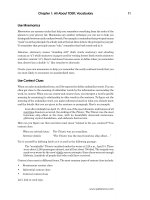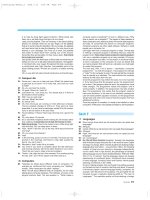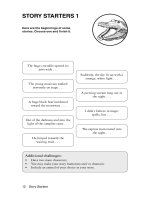READING JAPANESE - PART 3 docx
Bạn đang xem bản rút gọn của tài liệu. Xem và tải ngay bản đầy đủ của tài liệu tại đây (449.45 KB, 16 trang )
READING JAPANESE
三十三
ADDITIONAL PRACTICE
1. ガス
2. タイガー
3. ガード
4. ガイド
5. ギター
6. グリル
7. ニグロ
8. ゴール
9. グロテスク
10. ダイアローグ
11. カタログ
1. gasu 'gas'
2. taigaa 'tiger'
3. gaado 'guard[ing]'
4. gaido 'guide'
5. gitaa 'guitar'
6. guriru 'grill'
7. niguro 'Negro'
8. gooru 'goal'
9. gurotesuku 'grotesque'
10. daiaroogu 'dialogue'
11. katarogu 'catalogue'
(c) Nigori added to symbols representing syllables with initial s- changes the value to the
corresponding syllables beginning with z
Compare: ロース roosu 'roas[t]'
ローズ roozu 'rose'
READING JAPANESE
三十四
Examples:
ザ za ズ zu
ザール zaaru 'the Saar' ミズーリ mizuuri 'Missouri'
ジ zi
アジア azia 'Asia'
ADDITIONAL PRACTICE
1. デザート
2. イージー
3. ジーアイ
4. アジテーター
5. クイズ
6. スクイズ
7. マザー
8. マザースデー
9. シーザー
1. dezaato 'dessert'
2. iizii 'easy'
3. ziiai 'G.I.'
4. aziteetaa 'agitator'
5. kuizu 'quiz'
6. sukuizu 'squeeze'
7. mazaa 'mother'
8. mazaasudee 'Mother's Day'
9. siizaa 'Caesar'
READING JAPANESE
三十五
(d) Nigori added to symbols representing syllables with initial h- changes the value to the
corresponding syllables beginning with b
Compare: ホール hooru 'hole'
ボール booru 'ball' or 'bowl'
バ ba ビ bi
バリ bari 'Bali' ビルマ biruma 'Burma'
アラバマ arabama 'Alabama' リビア ribia 'Libya'
ババリア babaria 'Bavaria' ビキニ bikini 'Bikini'
バージニア baazinia 'Virginia' アラビア arabia 'Arabia'
ボ bo
ボゴタ bogota 'Bogota'
ボルガ boruga 'Volga'
ボリビア boribia 'Bolivia'
アイボリーコースト aiboriikoosuto 'Ivory Coast'
READING JAPANESE
三十六
ADDITIONAL PRACTICE
1. バス
5. バレー
9. タバコ
13. バスデー
2. ビル
6. ビール
10. ホビー
14. ダービー
3. ボス
7. ボート
11. ボーグ
15. ボルト
4. ボレロ
8. ボイルド
12. ボレー
16. バレーボール
1. basu 'bus'
5. baree 'ballet'
9. tabako 'tobacco'
13. basudee 'birthday'
2. biru 'buil[ding]'
6. biiru 'beer'
10. hobii 'hobby'
14. daabii 'derby'
3. bosu 'boss'
7. booto 'boat'
11. boogu 'vogue'
15. boruto 'bolt' or 'volt'
4. borero 'bolero'
8. boirudo 'boiled'
12. boree 'volley'
16. bareebooru 'volleyball'
2. The addition of a small circle ゜(called maru) to any kana symbol which represents a syllable
with initial h- changes the value to the corresponding syllable with initial p
Compare: ハイ hai 'high'
パイ pai 'pie'
READING JAPANESE
三十七
Examples:
パ pa
パリ pari 'Paris'
1
パラグアイ paraguai 'Paraguay'
パールハーバー paaruhaabaa 'Pearl Harbor'
ピ pi
ピサ pisa 'Pisa'
パイクス・ピーク paikusu・piiku 'Pike's Peak'
ポ po
ポー poo 'Po' (river)
ポルトガル porutogaru 'Portugal'
ポートサイド pootosaido 'Port Side'
1
This is a borrowing from French.
READING JAPANESE
三十八
ADDITIONAL PRACTICE
1. パパ
2. パス
3. パズル
4. パージ
5. パーマ
6. パーラー
7. パステル
8. デパート
9. パラダイス
10. パトロールカー
11. ピアノ
12. ピストル
13. ピクルス
14. ピーアール
15. ポーク
16. ポーズ
17. ポスト
18. ポスター
19. ポーター
20. ポーカー
21. ポニーテール
1. papa 'papa'
2. pasu 'pass'
3. pazuru 'puzzle'
4. paazi 'purge'
5. paama 'perma[nent wave]'
6. paaraa 'parlor'
7. pasuteru 'pastel'
8. depaato 'depart[ment store]'
9. paradaisu 'paradise'
10. patoroorukaa 'patrol car'
11. piano 'piano'
12. pisutoru 'pistol'
13. pikurusu 'pickles'
14. piiaaru 'P.R.' (public relations)
15. pooku 'Polk' or 'pork'
16. poozu 'pause'
17. posuto 'post'
18. posutaa 'poster'
19. pootaa 'porter'
20. pookaa 'poker'
21. poniiteeru 'pony-tail'
READING JAPANESE
三十九
LESSON 2 SUMMARY
wa
ra
ya
ma
ha
na
ta
sa
ka
a
ワ
ラ
ヤ
マ
ハ
バ
パ
タ
ダ
サ
ザ
カ
ガ
ア
ri
mi
hi
ni
ti
si
ki
i
リ
ミ
ヒ
ビ
ピ
ニ
シ
ジ
キ
ギ
イ
ru
yu
mu
hu
nu
tu
su
ku
u
ル
ス
ズ
ク
グ
re
me
he
ne
te
se
ke
e
レ
メ
テ
デ
ro
yo
mo
ho
no
to
so
ko
o
ロ
モ
ホ
ボ
ポ
ノ
ト
ド
コ
ゴ
オ
READING JAPANESE
四十
ROLOMAIL TRADING COMPANY
READING JAPANESE
四十一
LESSON 3
NOTES
The following additional procedures will help identify Japanese loanwords that occur in this lesson.
1. Is there an occurrence of syllabic ñ?
1
In word-final position or before a vowel it represents
English 'n'; with a following gu (or gu), it represents English 'ng'; elsewhere it assimilates to
the following sound, representing 'm', 'n', or 'ng'.
Examples: zooñ = 'zone'
noosumookiñgu = 'no smoking'
kañbozia = 'Cambodia'
roñdoñ = 'London'
bañkoku = 'Bangkok'
2. Is there an occurrence of t before i? The t may represent the initial sound of English 'cheap' or
'team', or (rarely) 'theme'.
Examples: tiri = 'Chile'
batikañ = 'Vatican'
sutiiru = 'steel'
etiopia = 'Ethiopia'
1
We use the diacritical ñ in this text to distinguish syllabic ‘n’ from the ‘n’ used in other romanized kana (na, ni, nu, ne, and no).
READING JAPANESE
四十二
3. Is there an occurrence of s before e? The s in this environment may represent the initial
consonant of English 'Chet', but more usually, of 'set'.
Examples: sero = 'cello'
seroteepu = 'cello[phane] tape'
Similarly, z (the voiced equivalent of s) before e may represent the voiced initial consonant of
English 'jet', but more usually, of 'zero'.
Examples: zerii = 'jelly'
zero = 'zero'
4. Is there an occurrence of h? It may represent the initial sound of English 'hood' or 'food' The
latter correspondence is particularly common when h is followed by the vowel u.
Examples: uuzuhuu = 'who's who'
hurañsu = 'France'
serohañ = 'cellophane'
Is there an occurrence of ho before wa? This combination may represent English 'wh' + vowel,
as in 'why', 'whine', etc. It approximates the 'hw' pronunciation used by some speakers of
English.
Example: howaito = 'white'
READING JAPANESE
四十三
5. Is there an occurrence of t before u? The t may represent the closest English equivalent̶i.e.,
'ts' as in 'tsetse'̶but more commonly it corresponds to the initial consonant of English 'too'.
Examples: pootumasu = 'Portsmouth'
tuu = 'two'
suutu = 'suit'
omuretu = 'omelet'
6, The consonant z before i, already identified as corresponding to the initial consonant of English
'jeep', 'zebra', and 'these', and the medial consonant of 'Asia', may also represent the initial
consonant of English 'deep'.
Example: sauziarabia = 'Saudi Arabia'
7. Is there an occurrence of a long e vowel? This may represent English 'y' + diphthong as well
as the more usual correspondence without the 'y'.
Example: eeru = 'ale' or 'Yale'
Japanese i before e may also correspond to English 'y' preceding the 'e' vowel, as in 'yes', 'yet',
etc.
Examples: iesu = 'yes'
iesumañ = 'yes-man'
READING JAPANESE
四十四
SYMBOLS AND EXAMPLES
Katakana symbol:
Romanization
Stroke Order
ン
ñ
Examples:
インド iñdo 'India'
コンゴ koñgo 'Congo'
ロンドン roñdoñ 'London'
ミシガン misigañ 'Michigan'
サイゴン saigoñ 'Saigon'
バンコク bañkoku 'Bangkok'
ワシントン wasiñtoñ 'Washington'
カンボジア kañbozia 'Cambodia'
キング kiñgu 'king'
コーニング kooniñgu 'Corning'
READING JAPANESE
四十五
Katakana symbol:
Romanization
Stroke Order
フ
hu
ブ
bu
プ
pu
Examples:
フランス hurañsu 'France'
アフリカ ahurika 'Africa'
フロリダ hurorida 'Florida'
サンフランシスコ sañhurañsisuko 'San Francisco'
ブラジル buraziru 'Brazil'
アルプス arupusu 'Alps'
READING JAPANESE
四十六
Katakana symbol:
Romanization
Stroke Order
エ
e
Examples:
エジプト eziputo 'Egypt'
イスラエル isuraeru 'Israel'
エクアドル ekuadoru 'Ecuador'
スイーデン sueedeñ 'Sweden'
エープリル eepuriru 'April'
エープリル・フール eepuriru・huuru 'April Fool'
エール eeru 'Yale' or 'ale'
イエス iesu 'yes'
イエスマン iesumañ 'yes-man'
READING JAPANESE
四十七
Katakana symbol:
Romanization
Stroke Order
ソ
so
ゾ
zo
Examples:
ソビエト sobieto 'Soviet [Union]'
エルパソ erupaso 'El Paso'
ソマリア somaria 'Somalia'
ソルトレーク sorutoreeku 'Salt Lake'
アマゾン amazoñ 'Amazon'
アゾレス azoresu 'Azores'
ソロ soro 'solo'
ソプラノ sopurano 'soprano'
メゾソプラノ mezosopurano 'mezzosoprano'
ゾーン zooñ 'zone'
アメリカン・ゾーン amerikañ・zooñ 'American Zone'
READING JAPANESE
四十八
Katakana symbol:
Romanization
Stroke Order
ウ
u
Examples:
ソウル souru 'Seoul'
ウルグアイ uruguai 'Uruguay'
サウスダコタ sausudakota 'South Dakota'
サウジアラビア sauziarabia 'Saudia Arabia'
ホワイトハウス howaitohausu 'White House'
ウエスト uesuto 'west'
ウエストポイント uesutopoiñto 'West Point'
ウエストバージニア uesutobaazinia 'West Virginia'
ウエーター ueetaa 'waiter'
ウエートレス ueetoresu 'waitress'
ウエー uee 'way'
ワンウエー wañuee 'one way'
ゴーイングマイウエー gooiñgumaiuee 'going my way'
ウーマンリブ uumañribu 'woman lib' (i.e., 'women's lib')









